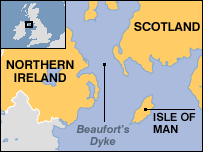Dangerous ticking time bombs under the Irish Sea
The idea of a bridge between Scotland and the north-east of Ireland has been the subject of a considerable amount of media interest recently. The present British Prime Minister, Boris Johnson, along with the leader of the Democratic Unionist Party (DUP) in Northern Ireland, Arlene Foster, have been keen to promote the idea. Not least because it is seen as a means of strengthening the union between Britain and the last remnant of the British colony in Ireland. This all comes at a time when a recent opinion poll showed a majority in the north of Ireland in support for Northern Ireland to leave the UK and join the Republic of Ireland; reunification.
So the idea of building a Scottish-Irish road bridge has taken on a certain urgency in the minds of the British government and the DUP. As already reported in an article by the Mannin (Isle of Man) Branch of the Celtic League, there are many hidden dangers in such a project. Not least of which is that it will have to be constructed through a heavily contaminated and extremely dangerous area of sea bed, the Beaufort Dyke. Beaufort's Dyke is a trench between Northern Ireland and Scotland within the North Channel, which connects the Irish Sea with the Atlantic Ocean, that was used as a munitions dump since early last century. Munitions dumped here are dangerously unstable and more than one million tonnes of weapons were jettisoned into the Beaufort Dyke, some in shallow waters surrounding the Dyke.
As if this dangerous British legacy was not enough to contend with when considering the Scottish-Irish road bridge, there is also the issue of cost. As reported in the Irish Post: "Boris Johnson’s proposed £15bn bridge between Northern Ireland and Scotland branded ‘bonkers’ by leading engineer". The article goes on to report on the view of Chris Wise, the engineering designer of the 2012 Olympic velodrome, who questioned both the practicality and price tag of such a plan. “If everything from the Olympics to HS2 are anything to go by, to quote the number and the price of any of these publicly funded projects this early without a design, in my view, is bonkers,” he said.
So taking aside the idea of the Scottish-Irish land bridge, it nevertheless leaves the issue of the need to make the Beaufort Dyke safe. In itself this will cost a huge amount, but it is an issue that needs to be addressed. The Dyke contains sarin and tabun (both nerve gases), phosgene, mustard gas and explosives. There is also the question of the oldest munitions in the Dyke losing their ability to withstand corrosion as they age. Over the years many of the munitions are breaking up and are dangerously unstable now. One thing that the "bonkers" idea of the bridge has at least drawn attention to, is that the issue of the de-ammunition of the Beaufort Dyke can no longer be ignored. This is where the money needs to be spent otherwise we will continue to have these dangerous ticking time bombs under the Irish Sea.







